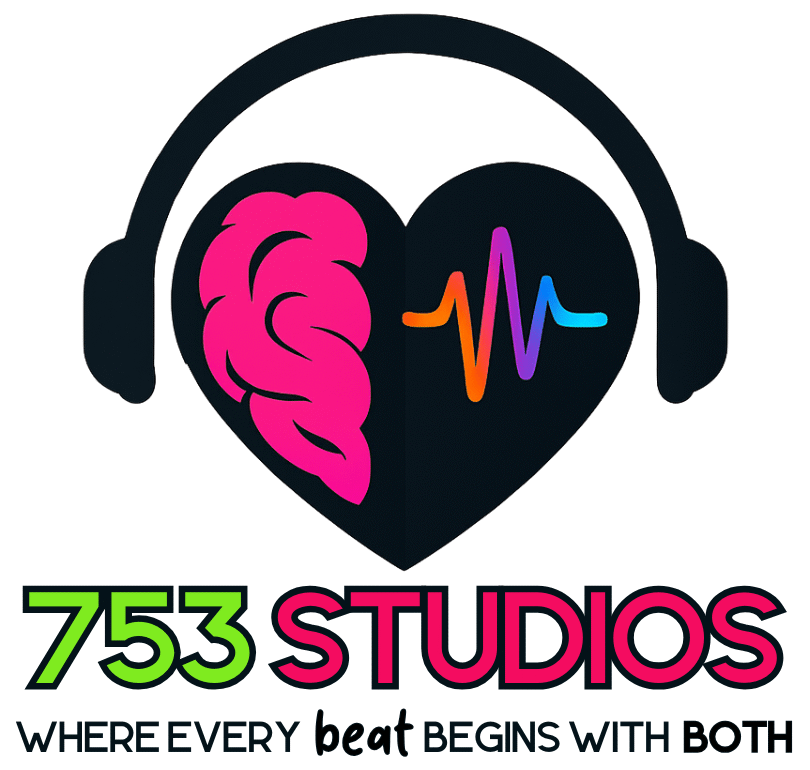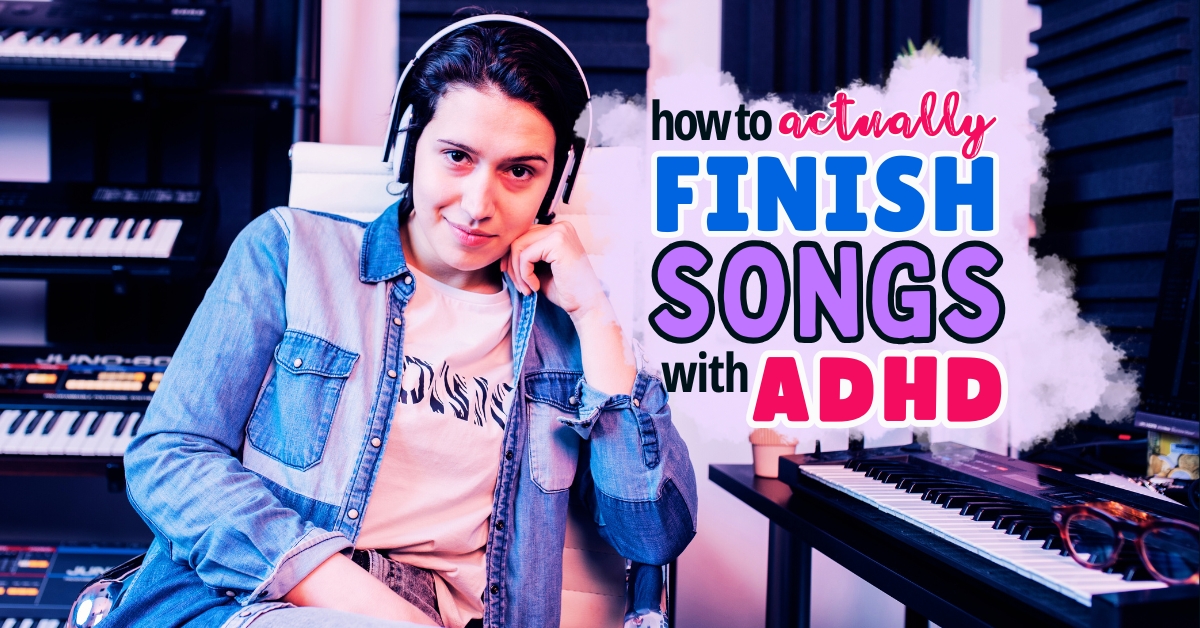Finishing a song when you have ADHD feels like trying to juggle flaming drumsticks while riding a unicycle… through a Guitar Center.
You start with a fire melody idea. Layer a beat. Add a bassline.
Then 17 minutes later, you’re knee deep into a YouTube rabbit hole on “how to make hyperpop breakcore polka.” Classic.
ADHD is a blessing
ADHD isn’t a curse. It’s a creative supercharger.
While the world’s busy coloring inside the lines, your brain’s inventing new shades.
ADHD gives you intense focus (when it hits), out-of-the-box thinking, emotional depth, and wild bursts of inspiration.
It’s not about “fixing” it. It’s about learning to harness it.
At 753 Studios, we don’t just work with ADHD—we create with it.
So, let’s talk tactics.
1. ⏳ Set “Done is Better Than Perfect” Deadlines
Perfectionism loves to masquerade as productivity.
You tell yourself you’re just “tweaking” the mix… but it’s been 3 hours and you’re EQing hi-hats only you can hear.
Here’s how to stop that cycle:
✅ Step 1: Set a 90-Minute Timer
Pick a task—arranging, sound design, mixing, whatever.
Set a timer for 90 minutes. That’s your container. No more. No less.
Why 90?
Well, it’s long enough to get into flow, and short enough to prevent burnout or endless second-guessing.
✅ Step 2: When Time’s Up, Bounce the Draft
Don’t argue with yourself. Don’t make “just one more change.”
Export the track.
Name it something fun or stupid, so you don’t take it too seriously (“emotional karate.wav” is fair game).
✅ Step 3: Upload It Privately (Google Drive, Dropbox, whatever)
Getting it out of your DAW and into the world—even privately—tricks your brain into feeling like you’ve finished something.
And that small win builds confidence.
✅ Step 4: Revisit It Later… or Don’t
After a few days (or a week), come back to it with fresh ears.
If it still slaps? Great. Release it or polish the mix.
If it doesn’t? That’s cool too.
Take the parts you like and move on.
Either way, you finished something.
This keeps the creative muscles moving.
Every unfinished song is taking up mental RAM.
Free it up by letting things be good enough.
Because to someone else, your track is Grammy-worthy.
2.🪞Face Imposter Syndrome Head-On
Beating perfectionism requires you to confront the voice in your heard that says:
“I’m not a real producer.”
“This track isn’t good enough.”
“Everyone else is better than me.”
That voice is lying.
Imposter syndrome hits especially hard when you have ADHD.
Why imposter syndrome hurts you:
Because you remember every unfinished idea, every missed deadline, and every time your focus bailed mid-session.
And you make it personal.
You start to tell yourself you aren’t cut out for this. That you are a failure.
But you forget the fire you’ve created, the growth you’ve had, and the fact that just showing up to make music in a chaotic world is already a flex.
Here’s the truth:
If you’re making music, you are a musician.
You don’t need a degree, a plaque, or a million streams to earn that title.
You just need the guts to keep going.
So next time that voice creeps in?
Tell it: “Thanks for your input, but I’ve got beats to finish.”
3. 🗑️ Ditch the Pressure to Finish in One Session
Your ADHD brain thrives in bursts. Not marathons.
Trying to finish a song in one sitting?
That’s like speed running a video game you’ve never played before while playing with a joystick that’s stuck drifting in the opposite direction than where you need to go.
Try break the process into phases:
- Session 1: Brain-dump ideas. No rules. Just vibes.
- Session 2: Structure it out. Verse? Chorus? Weird glitch breakdown? Cool.
- Session 3: Tweak sounds, automate, EQ, etc.
- Session 4: Final mixdown + bounce.
Give each phase its own time slot, and stop trying to be a hero by doing it all in one go.
You don’t get bonus points for burnout. So spread it out.
4.⚡Use Your Momentum
Okay, so you’ve yot a burst of creative energy? Use it!
When your creative juices are flowing, don’t wait for the “perfect time”.
Don’t save it for later.
Ride that creative wave while it’s high.
When your ADHD brain is lit up and firing on all cylinders, that’s not a fluke—that’s your zone.
Yeah, life’s got responsibilities. Handle what’s urgent, but the dishes can wait.
Move what isn’t life or death further down your to-do list.
When that creative window opens?
Give yourself permission to go all in.
Open your DAW. Hit record. Build something.
Momentum is magic for ADHD creatives.
If you don’t catch it when it hits? It’s gone like a snare in reverb.
Make the most of your momentum:
👉 6 Workflow Tips for ADHD Music Producers
5. 💤 Prep When Momentum Isn’t There
Let’s be honest: Some days, your brain feels like a browser with 42 tabs open… and none of them are loading.
That’s okay.
You don’t have to force creativity when it’s not there.
Instead, prep for future you.
Ways to prepare for boosts in creativity:
- Organize (and colorize them!) your sample folders
- Clean up your project files
- Save a new DAW template (you’ll thank yourself later)
- Jot down a few weird song title ideas
These low-energy tasks keep the creative engine warm without draining your mental battery.
Remember: Rest is part of the workflow—not a pause from it.
So when the spark returns? You’ll be ready to light it up.
6. 📊 Use Templates to Skip the Overwhelm
Blank sessions are the enemy.
Staring at an empty DAW is like opening a Word doc to write lyrics and forgetting every word you’ve ever known.
Set yourself up with a starter template, not a rulebook.
Here’s what to pre-load:
- Your favorite drum rack or sample pack (so you don’t spiral through 300 kick options)
- Buses and effects chains you use on every mix (drums, vox, reverb, etc.)
- Your usual tempo range (give yourself a head start, not a straightjacket)
- Tracks labeled and color-coded in a way your brain actually understands
Think of it as a “welcome mat” for your next idea.
It’s like meal prepping, but for beats. (And way less soggy, iykyk.)
7. 📁 Create a “Song Seed” Folder
Your ADHD brain is a goldmine of half-finished ideas. Embrace it.
Build a vault of short, strong “song seeds” — 8-bar loops, chorus hooks, cool synth patches, voice memos of you beatboxing in traffic (hey, no judgment).
Then, on low-focus days, instead of starting from scratch, you build from your own bank of brilliance.
Bonus: Naming your loops something dumb like “Sad Banger 2” or “Alien Booty Groove” makes this process 42% more fun. Science.*
8. 🙏 Protect Your Focus Like It Owes You Money
When you sit down to work on a track, turn off the internet.
Which means when you sit down to finish a track, your brain suddenly cares deeply about reorganizing your plugins, deep-cleaning your desk, or Googling “how to build a synth from scratch.”
So, here’s how to protect your creative zone like it’s sacred:
✈️ Airplane Mode Your Phone
Seriously. Notifications are dopamine traps.
Unless your house is on fire or Kendrick is texting you, it can wait.
🔒 Use a Browser Blocker
Apps like Cold Turkey, Freedom, or Forest are great for shutting the digital doors.
You can whitelist your DAW and reference tools.
Everything else? Locked out.
🎵 Create a Sonic Bubble
Put on a low-distraction playlist, ambient noise, or better yet: Loop a beat you’re working on.
This tricks your brain into staying connected to the project instead of wandering into soundless chaos.
🧠 Protect Your Focus Like It’s Gold
Your attention span is a limited resource—treat it like the last open mic slot in a room full of hungry MCs.
Guard it. Use it intentionally.
When you’ve got it, don’t waste it on Reddit holes and plugin rabbit trails.
Final Thoughts (That Your Brain Will Probably Skim Anyway)
You’re not lazy. You’re not flaky.
You’re a high-powered creative force operating with a nonlinear processor.
And finishing music is possible. You just need systems that respect your brain’s rhythm.
At 753 Studios, we build content for the ADHD musician who’s got 23 ideas, 12 half-finished bangers, and a whole lot of heart.
Need more tools like ADHD-friendly project templates or practice planners?
Check out our other posts, because you deserve to create at your own pace, not society’s.


